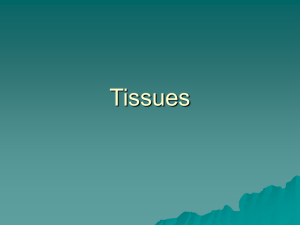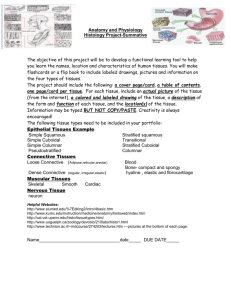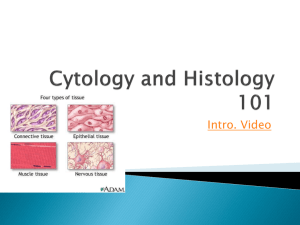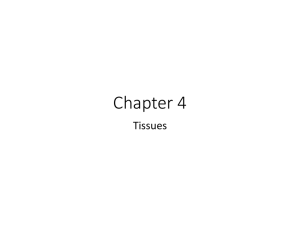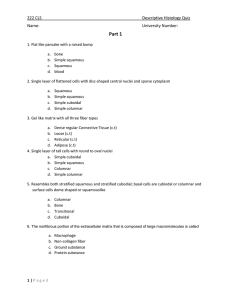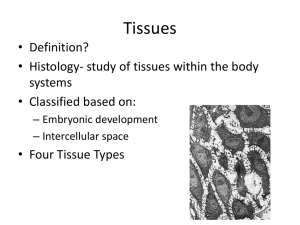I. Tissue intercellular substance that performs a specialized function
advertisement
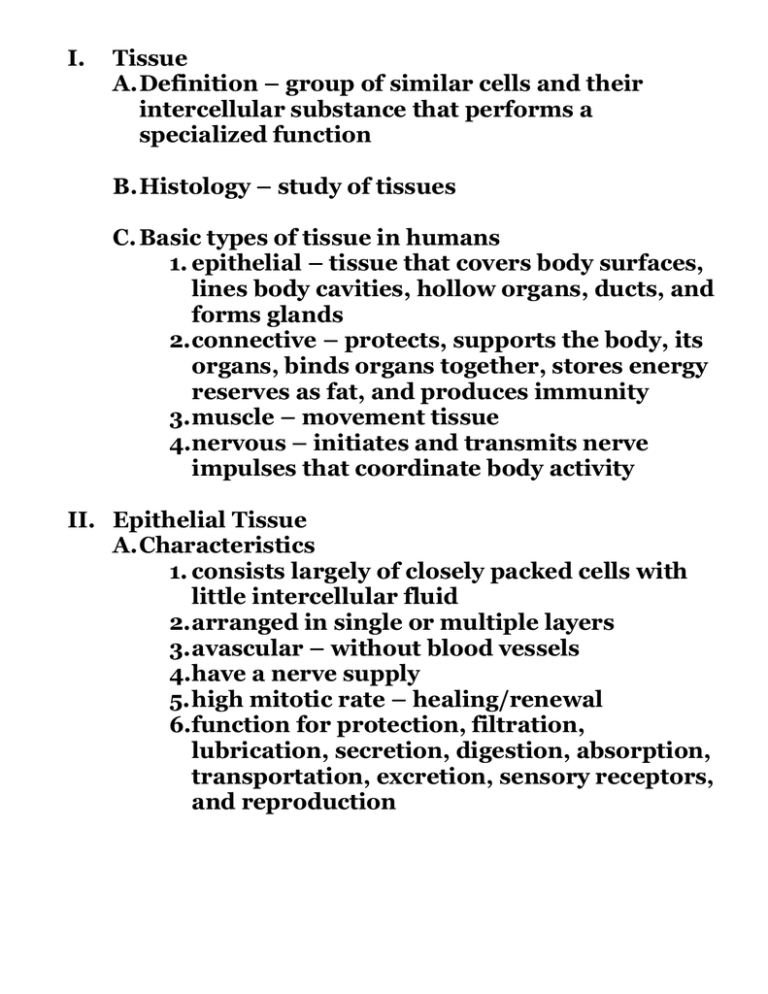
I. Tissue A. Definition – group of similar cells and their intercellular substance that performs a specialized function B. Histology – study of tissues C. Basic types of tissue in humans 1. epithelial – tissue that covers body surfaces, lines body cavities, hollow organs, ducts, and forms glands 2. connective – protects, supports the body, its organs, binds organs together, stores energy reserves as fat, and produces immunity 3. muscle – movement tissue 4.nervous – initiates and transmits nerve impulses that coordinate body activity II. Epithelial Tissue A. Characteristics 1. consists largely of closely packed cells with little intercellular fluid 2. arranged in single or multiple layers 3. avascular – without blood vessels 4.have a nerve supply 5. high mitotic rate – healing/renewal 6.function for protection, filtration, lubrication, secretion, digestion, absorption, transportation, excretion, sensory receptors, and reproduction B. Arrangement of layers 1. simple – single later of cells found in areas where passive and active transport are needed 2. stratified – two or more layers used for protection of underlying tissue in areas of wear & tear 3. pseudostratified – one layer of a mixture of cell shapes – looks multi-layered C. Cell shapes 1. squamous – flat and attached together like tiles 2. cuboidal – cube or hexagonal shape - produce secretions (sweat, enzymes) - can absorb – intestinal tract 3. columnar – tall and cylindrical – protection of underlying tissue – specialized for secretion and absorption, - can have cilia 4.transitional – cells vary in shape - flat to columnar due to stretching of the tissue D.Layers and shapes – basis for classification of tissue 1. simple – squamous, cuboidal, columar 2. stratified – squamous, cuboidal, columnar, transitional 3. pseudostratified –columnar epithelium E. Glandular epithelium – functions for secretions - cells lie below outer epithelium 1. endocrine – ductless glands – hormones 2. exocrine – secreted into ducts – mucous, sweat, oil, digestive enzymes III. Connective Tissue – most abundant tissue in the body – (embryonic is mesenchyme – all connective tissues come from this) A. Connective tissue proper – intercellular material and matrix –hyaluronic acid – vicous, slippery substance that binds cells – - chondroitin sulfate - provides support and adhesiveness in cartilage, bone, skin, and blood vessels B. Loose (areolar) tissue - most widely distributed 1. Fibrous a. collagenous - (white), tough, resistant to pulling, made of collagen b.elastic – (yellow), smaller, provides strength, skin, blood vessels, and lungs c. reticular – thin – immature collagen – collagen coated with glyco-protein – supports walls of blood vessels, nerve cells, and smooth cells – forms stroma – framework of spleen and lymph nodes 2. Cells a. fibroblasts – most numerous especially active in repair b.macrophages – large and function to engulf bacteria and cellular debris by phagocytosis c. plasma cells – secrete antibodies – immunity d.melanocytes – pigmented cells below the deepest layer of skin – produce melanin e. mast cells – produce heparin(anti coagulant) and histamine – a chemical that dialates small blood vessels during inflammation 3. Location – widespread - (mucous membranes), around blood vessels, and nerves, subcutaneous B. Adipose tissue – tissue composed of cells called adipocytes – fat storage 1. shape – signet ring shaped 2. subcutaneous – location 3. functions - good insulation, energy reserve, protection of internal organs C. Dense collagenous tissue – more numerous cells and thicker fibers 1. locations – muscles, ligaments, tendons 2. functions – provide elasticity D.Elastic tissue 1. structure – freely branched fibers – stretch and snap back 2. location – muscles, ligaments, tendons 3. function – allow for elasticity E. Cartilage – no blood vessels or nerves except in the perichondrium – tissue around cartilage 1. characteristics a. dense network of collagin and chondroitin sulfate b.resilient c. strong 2. types a. hyaline – gristle – bluish white color, shiny substance, - most abundant - found in embryonic skeleton (exclusively) - found on the end of long bones and costal region b. fibrocartilage - found in matrix to give strength - bundles of collagin fibers - threadlike network for elasticity d.elastic threadlike network for elasticity F. Osseous tissue (bone) – skeletal system – basic unit is osteon – composed of: 1. lamellae – concentric rings of hard matrix calcium 2. lacunae – spaces between lamellae – has Haversian canal – contains blood vessels and nerves G. Vascular tissue (blood) – connective tissue – plasma – mostly H2O with dissolved substances such as nutrients, wasts, enzymes, hormones, respiratory gasses (O2, CO2) 1. erythrocytes – red blood cells 2. leucocytes – phagocytosis, immunity 3. platelets - clotting IV. Other tissue A. membranes (pg 95) B. muscle tissue – high specialized cells for contraction 1. smooth – walls of internal organs (hollow) – involuntary – non striated 2. cardiac – wall of heart – involuntary – striated – 1 nucleus 3. skeletal – striated, voluntary, fibers are cylindrical and striated – multiple nucleus C. nerve tissue - consists of neurons 1. neurons – cells that receive stimulus and convert to impulse, as well as carry impulses to other nerves, muscles or glands. a. Dendrites – converging branches the take the impulse towards the cell body b. Axons – long, single strand that conducts impulses away from the cell body 2. neuroglea - cells for protection and support of neurons a. they do not conduct b. common site of tumors
